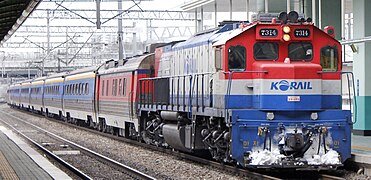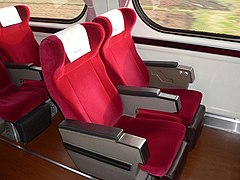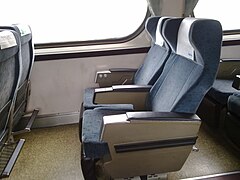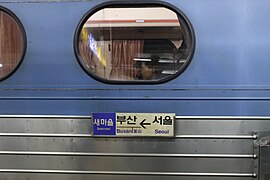Saemaeul-ho
This article needs additional citations for verification. (May 2014) |
| Saemaeul-ho | |
|---|---|
 Saemaeul-ho train hauled by a Hyundai Precision GT26CW-2 locomotive at Suwon Station. | |
| Overview | |
| Service type | Regional rail |
| Status | Operating (along Janghang Line) |
| Locale | South Korea |
| First service | February 10, 1969 |
| Successor | ITX-Saemaeul |
| Current operator(s) | Korail |
| Route | |
| Start | Yongsan |
| Stops | 18 |
| End | Iksan |
| Line(s) used | Janghang Line |
| Technical | |
| Rolling stock | |
| Track gauge | 1,435 mm (4 ft 8+1⁄2 in) standard gauge |
| Saemaeul-ho | |
| Hangul | |
|---|---|
| Hanja | 새마을號 |
| Revised Romanization | Saemaeulho |
| McCune–Reischauer | Saemaŭlho |
The Saemaeul-ho, formerly known as the Saemaul-ho and Saemaul Express, is a class of train operated by Korail, the national railroad of South Korea, since February 8, 1969. Before the introduction of the KTX express trains, the Saemaeul-ho was the fastest class of trains in South Korea, making the journey from Seoul to Busan in less than 5 hours. Saemaeul trains operated on several lines, but they now only operate on the Janghang Line.
Saemaeul-ho trains are distinguished from the more basic Mugunghwa-ho trains by their larger and comfortable seats and the absence of standing passengers. Trains are also distinguished from the Mugunghwa-ho trains by their colour; typical Saemaeul train passenger cars are painted in red and black. In the past, Saemaeul passenger cars were painted in green, blue, and yellow. The length of a Saemaeul train varies from 5 cars to 12 cars, either as one or two sets; certain Saemaeul-ho trains that ran from Seoul to Busan separated at Gupo station, with one half travelling along the Bujeon Line and Donghae Nambu Line to Haeundae, and the travelling down the main Gyeongbu Line to Busan station.
The Saemaeul-ho took its name from the Saemaul Undong, a movement for rural revitalization spearheaded by Park Chung-hee in the 1970s.


The Saemaeul-ho class was phased out on all lines except the Janghang Line by the ITX-Saemaeul starting on May 12, 2014. The new ITX-Saemaeul trains have a faster average speed of 150 kilometers per hour, and replaced the older Saemaeul trains gradually until April 30, 2018.[1]
Rolling stock numbers[]
- Streamlined Saemaeul passenger car (1986-1993) - #38–39, #10031–10033, #10051–10059
- Diesel Hydraulic Car (DHC) (also known as Push-Pull) (1987-2013)- #101–216, #251–262, #301–446, #501–513, #521–585, #611–649, #701–715, #751–755, #781–787
- Long-length Saemaeul passenger car (1990-2015) - #41–50, 10041–10047, #10086, #11084–11101
- Limit passenger car (refurbished for Saemaeul service) (2017-present)

Carriage[]
Rectangular carriage[]
Right angle type Saemaeul coach On February 8, 1969, the Saemaul-ho was built and introduced in succession from 1982 until the year of its opening. In early 1975, Daewoo Heavy Industries Co., Ltd., which was preparing for the development of high-class domestic passenger cars, supplied 2 units, which were successfully developed and manufactured in the design based on Japan imported Saemaul coach cars. From 1979 to 1982, it was distributed to Daewoo Heavy Industries and Hyundai Precision Industries. Welded research steel plate, mild steel material, the wall is designed to be rectangular. The guest room garden was usually 56 seats and was the seat of a typical Japanese limited train style. The armrests had the same color as the seat, and the reclining angle was so great that it would hinder the backseat. There were no calves or braces. The initial painting was based on ivory color, and consisted of a window line and a blue band at the lower end of the carriage. It was similar to the Japanese Shinkansen 0 system. In addition, the NT-21 bogie of the disc braking type was applied for the high-speed driving at the beginning, and the air spring bogie was applied to the 10 pieces of the special passenger car made in Hyundai Precision in 1982. There was a standard room, a dining room car, a separate room car, a restaurant combination room special car[2] and a prospective coach car. A rectangular car was operated by the Saemaul Arirang Yoram train, which operated on December 31, 2007. All were retired.
Streamlined carriage[]
The second-generation train was introduced with the 7000-train locomotive from 1986 to 1988. The length of the car was increased from 21m to 23.5m and the seat was increased to 64 seats. To make the seat more spacious. One of the differences compared to the first-generation passenger car is that the existing spring cushion is replaced with a cotton cushion, an armrest is added to the center, and a folding table is installed on both ends of the armrest. In addition, automatic cabin door which existed only in a rectangular cabin was applied to all rooms, and the automatic door was installed for the first time in Korea. Indirect lighting was adopted for the first time, and individual reading lights were installed.
However, due to differences in service quality with long - haul carriages, streamlined carriages were downgraded to full - size cabins in Mugunghwa in 1993, and were then downgraded to ordinary rooms.[3] Since 1996, he has begun to renovate a streamlined carriage with headrests and legless seats.[4] In the process of retrofitting, all backrests without headrests have disappeared, but the replacement of heat sinks for heating is not possible.[5] There was a LED signboard inside the room together with the same type of Saemaulho which was produced and introduced in 1988 but it was temporarily incompatible with the same type Saemaulho which was produced and introduced in 1992, The publisher was changed to be compatible with the production and introduction vehicles of 1992.
Long carriage[]
It was introduced from 1990 to 1999, and it is a new type of cabin that the room facilities were changed greatly compared to the previous vehicles. It raised the service space of washrooms and toilets to a considerable level, and provided instantaneous coolers, water heaters and drinking water. Since then, there has been room for the installation of mobile public telephones. The bathroom had no opaque glass windows (completely closed with no windows), and the entrance door was the same as the room interior. The seat was transformed from a conventional brown sheet to a purple sheet with a luxurious pattern, and a LED signboard was placed on the door of the room to display various information as captions. He also operated a smoking room. In 1991, the carriage was installed and installed on the outside of the door. 45-seater coach cars also appeared and operated on the Gyeongbu Line.[6] Since 1991, they were no longer producing or introducing them.
The body was the same as the stainless steel bodywork of the Saemaul Autonomous Vehicle. The painting was the first painting of the Saemaul Autumn Vehicle with a red line on the window. The letters on the LED display board in the car were greenish-green, with a unique font, and the letter size accounted for two-thirds of the display board.[7] In the process of unification with the coloring of Korean railway, both of the carriage type and the homogeneous type were replaced with a relatively ordinary one and disappeared.
An electric water heater was installed in the washroom in the service area, but water temperature was freely controlled. On December 3, 1999, a fire caused by a short circuit in Noryangjin Station resulted in the burning of one car (524) in the early 2000s. . The bathroom shelf was originally a sink and flower arrangement, which was demolished due to administrative difficulties. On the opposite side of the sink, a portable wireless public telephone operated by Korea Mobile Communications, which was piloted in 1994 and expanded to all vehicles in 1995, was installed, and personal phones were rapidly spread and demolished in the 2000s. At present, there is a button-type drinking water bottle with a disposable paper cup at the place where there is an air pressure gauge and a trash can, In the 2000s,[8] all LED devices were demolished and video broadcasting equipment (KOMONET) was installed in the car-shaped Saemaul rivers. In February 2008, due to the condition of broadcasting companies, broadcasting was suspended and the middle monitor was removed. And it became ineffective.
Suite carriage[]
Special-sized carriages have the same specifications as regular rooms, except that the capacity is 60 persons.
In addition to the number of seats, the illumination of the individual lighting can be adjusted, the installation of personal audio equipment by the program, and the retractable legrest (calf rest) existed.
Among the suites, a 2x1 arrayed passenger carriage also operated.
All doors are automatic doors from the beginning of the introduction, and are equipped with a non-acid washroom and a restroom.
In addition, various tourist trains operate in the form of collecting fares and fees for the Saemaeul Special Zone, and use vehicles such as the Mugunghwa Hana Nuri, or the small-lorry and commuter-type diesel vehicles.
Remodeled carriage[]
In January 2013, Korail have remodeled the remaining coasters after the demolition of the Saemaul-type diesel hydraulic car. Since 1992, the specification is almost the same as the large Saemaeulho. Conventional streamlined and long-haul carriages have no jumper lines in the same vehicle type, so it was impossible to operate them by homogeneous knitting. On the contrary, these coaches were not able to operate as coaches that were connected to locomotives. Therefore, remodeling work was done to connect with locomotive and mix with existing carriage.
Mugunghwa-ho remodeled carriage[]
Since the durability of streamline passenger cars and convertible passenger coaches has expired at the end of April 30, 2018, except for the vehicles modified to the Mugunghwa Special Passenger Units and the three cars introduced in 1999, they will be operated from May 1, 2018 . The Limit carriage of Mugunghwa coaches was remodeled and the same color scheme as ITX-Saemaul was adopted. The seating capacity is 72 seats, and each seat has a 220V outlet and a USB charging terminal.
Related culture[]
Social status[]
Until the first KTX rating was established on April 1, 2004, the Saemaeulho was responsible for the highest grade train, and the Saemaulho had a very high social status. Especially in the early 1960s and 1970s, it was recognized that VIPs or wealthy people were trains on the train.
Restaurant Car[]
In 1969, at the time of the introduction of the tourism lake, the dining car was operated under the name "SALON".[9] It was first run by the Korean National Railroad, and in 1986, the outsourcing commissioned privatization of the outskirts, and the Seoul Plaza Hotel was operated by the Saemaeul-ho and Mugunghwa-ho restaurants until March 31, 2004.
Until the end of the 1990s, all the Saemaeulho (plus some Mugunghwa) except for some weekend trains were connected to the dining car. However, in 1999, since the restaurant was removed from the Saemaul rivers in Janghang, . In the 2000s, some non-mealtime trains operated the Lotteria in the dining room car instead of the dining room.[10] From July 2003, the Seoul Plaza Hotel returned the diner car operation of the train at the non-meal time, As a consortium.[11]
There were one chef,[12][13] one manager, and one or two serving[14] on the dining car. The chef supervised the cooking, the manager supervised the cash register, and the staff in charge of the service performed the service in the dining room and sold the lunch box or the room moving room. In the car, they sold lunch boxes,[15] Western food,[16] Korean food,[17] liquor[18] Many problems have been pointed out, such as high prices compared to the quality of trains operated on trains, the problem of detecting E. coli that was reported to the press if forgotten, and the use of factory products containing retort and cans in some menus such as curry rice.
Since April 1, 2004, KTX was opened and the number of passengers using the dining room was reduced, and Seoul Plaza Hotel returned the operating rights of the dining car to run the lunch bar. Although the dining car stopped operating on trains except for some meals for about two years immediately after the opening of KTX, the restaurant car was connected to all trains again from 2006. However, as most of the Saemaulng visitors were using KTX, the number of passengers in the dining room naturally decreased. In 2008, the dining car was abolished and reorganized into a train cafe.
Train cafes sell lunches, sandwiches, confectionery, drinks, liquors and soups. There are cell phone rapid chargers, game machines and computers,[19] mini concert rooms and therapy rooms.[20] On May 7th, 2012, KORAIL Tourism Development Co., Ltd. introduced rail lock, which is a train-only lunch box, and sold the rail lock instead of the existing lunch box in Saemaeul-ho train cafe.

Lines Served[]
- Janghang Line; 장항선, by Diesel Locomotive : Yongsan-Iksan; 용산-익산
Former operations[]
- Gyeongui Line; 경의선, by DHC : Seoul-Dorasan, Imjingang-Dorasan; 서울-도라산, 임진강-도라산 - ceased on June 30, 2009.
- Jungang, Yeongdong and Taebaek Line : Cheongnyangni-Andong/Gangneung - ceased in November 2006. Cheongnyangni-Andong ceased in October 2014.
- Honam Line; 호남선, by DHC, diesel locomotives, : Yongsan-Gwangju/Mokpo; 용산-광주/목포 - ceased in June 2014
- Jeolla Line; 전라선, by DHC, diesel locomotives, : Yongsan-Yeosu; 용산-여수 - ceased in June 2014
- Gyeongbu Line
- Donghae Nambu Line; 동해남부선, by diesel locomotives : Seoul-Pohang; 서울-포항 - ceased on April 2, 2015
Notable accidents[]
'Three-times-in-a-row' accident[]
On May 1, 2002, Saemaeul-ho #162, from Yeosu to Seoul through Jeolla Line, Honam Line and Gyeongbu Line, ran over three people in total, each person in each different railroad crossing, three times in a row. The first accident happened 26 minutes after departure from Yeosu Station, at railroad crossing nearby Yulchon Station. #162 ran over 81-year-old female. After changing engineer, #162 continued its heading to Seoul. However at 13:00 KST, #162 collided with 82-year-old female again, at in-station railway bridge in Samnye Station. Yet again replacing engineer, #162 entered through Honam Line, continuing to Seoul. But only 40 minutes after second incident, #162 killed third person, 90-year-old male, at railroad crossing nearby Hamyeol Station. In South Korea, many press reported it as "Third-times-in-a-row railroad crossing incidents"(Korean: 3연속 건널목 사망 사고). It was first such accident in the World, according to Korean National Railroad at that time. The train arrived at Seoul with 36 minutes delay, and immediately after arrival, KNR held requiem ceremony for the three victims in these accidents.[21]
See also[]
Gallery[]

Saemaeul-ho type diesel hydraulic pressure vehicle (Retired)

Saemaeul-ho type diesel hydraulic pressure vehicle (old paint)

Diesel locomotives trains Car-type Saemaeul-ho (End of service, but occasionally group tour train or occasional temporary train)

Saemaeul-ho Exp. Normal Seat

Saemaeul-seat-pitch-interval

Saemaeul-ho Express Push-Pull DHC Railcar Last run

Traveling on a Saemaeul-ho from Seoul to Busan. (At the end of service)

Rectangular carriage
ITX-Saemaeul Train

Mugunghwa Train Modification Saemaul Train
References[]
- ^ "Yonhap New Agency". english.yonhapnews.co.kr.
- ^ Half of the room / Half called the restaurant as a so-called halter.
- ^ This carriage is called "old mugunghwa" in the meaning of "old cabin for special rooms".
- ^ It was the same as the seat of Tongil Hall or Mugunghwa Privileged Train
- ^ Even some of the carriages remodeled the backrest with the lower body untouched.
- ^ The seating arrangement was a 2x1 configuration. Compared to the more spacious seats, the legrest is equipped with exactly what was used in the 2x2 arrangement, which is somewhat uncomfortable for the actual ride.
- ^ Originally, the size of the character window of the electronic signboard was designed accordingly.
- ^ It was removed from the new Mugunghwa coach car which was built and introduced from 1994 to 1995, which borrowed the same design as the Saemaulho service space.
- ^ The Kwan-Gwang Ho is not the first dining car in Korea.
- ^ Due to the nature of the train operation, the complaints of the passengers were not disrupted and the deficit was increased.
- ^ Lunchbell Co., Ltd., which operated a dining car until the restaurant car was reorganized into a café carriage, was the company that operated the dining car.
- ^ From the beginning of the dining car to early 1994, and from early 2001 to early 2004. In the middle of the gap period, all the menus were cooked in the same manner as the airplane meals in order to improve the quality of the food in the train dining room, and then it was not necessary to have a chef since it was provided to the microwave oven .
- ^ Then, in early 2001, he reorganized the train restaurant in the name of Plaza Express. He was able to cook again on the train and provided him with a menu, which served him for several years before he left the train restaurant business.
- ^ However, in the case of the production of some semi-trailer vehicles such as Seoul-Janghang, Cheongryangri-Andong, the waiter was also a one-person sales system that serves food alone and in-car sales. In addition, the number of menus to be sold in comparison with other train restaurants was small, because the vehicle of this antitheft response type was often attached to a short distance or a train with low demand.
- ^ The lunch box sold at the Saemaulho restaurant was used as a lunch box of Hanwha Hotel & Resort. The Plaza Hotel itself is a Hanwha Group affiliate, and the restaurant business division, which served as a train restaurant business, was separated into Hanwha Development as a subsidiary.
- ^ In the early days when plaza Hotel passed the goodwill, there were many food-oriented menus, and there were some form menus that were unfamiliar in Korea and easy to handle in the dining car.
- ^ Beginning with the goodwill of the Seoul Plaza Hotel in the early 1990s, it began to appear one by one, starting with the roasted meats.
- ^ Beer, Korean wine, and Baekseju were the main focus. In the 2000s, standard-style whiskey such as Passport, which was not treated well by other brand-name whiskeys, was also on the menu under the name of premium whiskey.
- ^ Internet PCs have been removed from most trains due to the low usage rate due to the spread of smartphones.
- ^ Karaoke equipment was installed in the mini concert room, massage chair was installed in the therapy room. The utilization rate is also low, and it has been long since it has been reduced to a space complex.
- ^ 지난 1일 여수發 서울行… 3시간새 한열차에 3명 치여, 동아일보, 2002-05-02. Retrieved on 2020-09-26.
External links[]
- Named passenger trains of South Korea
- Passenger trains of the Korail









